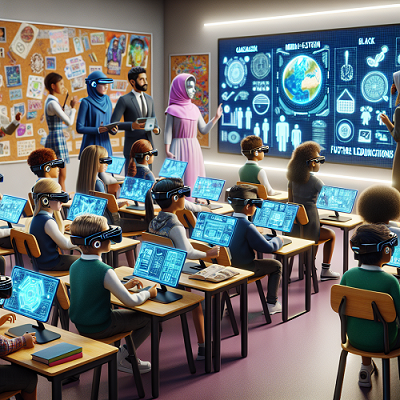Introduction: Setting the Scene for Innovation
The landscape of education is undergoing a monumental shift, thanks in large part to the integration of technology. This transformation is not just about the digitalization of traditional learning methods but about reimagining the very essence of how we learn. The COVID-19 pandemic, a catalyst for change, has accelerated the adoption of EdTech solutions, proving that technology in education is not just a luxury but a necessity.
The Rise of AI and Machine Learning
Artificial Intelligence (AI) and Machine Learning are at the forefront of this educational revolution. Personalized learning experiences, tailored to the individual needs and learning styles of students, are made possible through AI. Automated grading systems free up valuable time for educators to focus on teaching rather than administrative tasks. Moreover, machine learning algorithms are being developed to analyze learning patterns, offering insights to continually improve educational content and delivery methods.
Immersive Learning Through AR and VR
Augmented Reality (AR) and Virtual Reality (VR) are transforming the classroom into an immersive learning environment. These technologies create engaging and interactive experiences that can transport students to historical sites, simulate complex scientific experiments, or provide hands-on training without the risks associated with real-world practice. Successful case studies range from AR/VR implementation in K-12 classrooms to professional training programs, demonstrating the vast potential of these technologies in education.
Blockchain’s Role in Education
Blockchain technology, though primarily associated with cryptocurrencies, holds significant promise for the education sector. Its ability to provide secure, immutable record-keeping is a game-changer for credential verification and the management of academic records. Furthermore, blockchain paves the way for a decentralized education system, where learners can access a global network of educational resources and credentials, free from the constraints of traditional institutions.
The Expansion of Microlearning Platforms
Microlearning, the practice of delivering content in small, manageable segments, is gaining traction as a powerful educational tool. This approach caters to the modern learner’s need for flexible, bite-sized learning opportunities that fit into their busy lives. Microlearning platforms are proliferating, offering courses and modules that users can consume at their own pace, anytime, anywhere.
Gamification: Making Learning Fun Again
Gamification introduces game design elements into the learning process, making education both fun and effective. Points, badges, leaderboards, and challenges boost engagement and motivation, turning learning into an enjoyable activity rather than a chore. The impact of gamified learning experiences on student outcomes is profound, with increased retention rates and improved performance.
The Growth of STEAM Education
The integration of the Arts into STEM (Science, Technology, Engineering, and Mathematics) to form STEAM education is a trend that recognizes the importance of creativity and critical thinking alongside technical skills. Technology plays a crucial role in facilitating this integration, enabling the creation of interdisciplinary projects that prepare students for the challenges of the future.
Bridging the Digital Divide
Despite the advancements in EdTech, the digital divide remains a significant barrier to equitable access to education. Initiatives aimed at closing this gap are critical, ensuring that all students, regardless of their socio-economic background, have access to the tools and resources they need to succeed in a digital world.
Looking Ahead: The Future of EdTech
As we look to the future, the next big trends in education technology are likely to further personalize and democratize learning. The importance of adaptability and continuous learning cannot be overstated in this rapidly evolving landscape. By exploring these trends, educators, technologists, and policymakers can collaborate to create innovative solutions that enhance learning experiences and outcomes for students around the globe.
The journey through the evolving world of EdTech is an exciting one, filled with opportunities to reshape education for the better. As we navigate these emerging trends, the focus must remain on creating inclusive, engaging, and effective learning environments that prepare students for the challenges and opportunities of the future.



